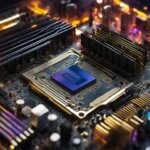Table of Contents
Non-uniform memory access (NUMA) is a method of configuring a cluster of microprocessors in a multiprocessing system to share memory locally. This improves the system’s performance and allows for scalability as processing needs expand.
In a NUMA setup, individual processors share local memory and can work together, enhancing data flow and minimizing latency. NUMA can be viewed as a microprocessor cluster in a box, with each cluster consisting of processors interconnected on a local bus to a shared memory on a single motherboard.
NUMA is commonly used in data mining applications and decision support systems, where parallel processing and shared memory are crucial. It eliminates the performance bottleneck associated with adding microprocessors in an SMP system, simplifying programming and reducing data replication.
How NUMA Works
In a NUMA system, the data access process involves multiple levels of memory and caching mechanisms, resulting in efficient data flow and low latency.
When a processor in a NUMA system seeks data at a specific memory address, it first checks its own local memory. If the data is not found in the local memory, the processor then searches in the L1 cache, followed by the L2 cache.
If the data is still not found, the system utilizes the NUMA configuration, which includes an intermediate level of memory known as the L3 cache. The L3 cache is shared among a subset of microprocessors, ensuring faster access to data shared within the cluster.
If the data is not present in any of the processor’s caches or the L3 cache, the processor will access the remote memory, which is located near other microprocessors in the system. This remote memory can act as a last resort for accessing required data.
The hierarchical view and efficient data movement in a NUMA system contribute to the fast data flow and low latency. NUMA maintains a coherent view of data across nodes, enabling seamless sharing and synchronization.
Data is moved between clusters or nodes using buses equipped with scalable coherent interfaces (SCIs). These SCIs ensure cache coherence across the nodes, maintaining consistency in the shared memory and preventing conflicts.
Overall, the NUMA architecture and its multi-level caching hierarchy, intermediate memory, and efficient data movement mechanism enable enhanced performance and responsiveness in multiprocessor systems.
Caching Hierarchy in NUMA
The caching hierarchy in NUMA systems can be summarized as follows:
| Memory/Caching Level | Description |
|---|---|
| Local memory | Each processor has its own private local memory. |
| L1 cache | The first level of cache dedicated to each processor. |
| L2 cache | The second level of cache specific to each processor. |
| L3 cache | An intermediate level of cache shared among a subset of processors. |
| Remote memory | Memory located near other microprocessors, accessed when data is not found in the local caches. |
This caching hierarchy ensures efficient data access and reduces latency by prioritizing local memory and caches before resorting to remote memory.
Advantages and Disadvantages of NUMA
NUMA, or non-uniform memory access, offers several advantages in multiprocessing systems. It enables fast data movement and lower latency, resulting in improved system performance. With NUMA, data replication is reduced, leading to more efficient memory utilization. Additionally, programming becomes simplified, making it easier to allocate and manage data in local memories.
Parallel computers in a NUMA architecture are highly scalable and responsive to data allocation. This means that as processing needs evolve, the system can be easily expanded without sacrificing performance. NUMA’s ability to handle data flow efficiently contributes to its effectiveness in enhancing system responsiveness.
However, there are also some disadvantages associated with NUMA. One of the main drawbacks is the expense of implementing specialized hardware required for NUMA configurations. This can make it costly to set up and maintain NUMA systems, which may deter some organizations from adopting this architecture.
Another challenge is the lack of programming standards for larger NUMA configurations. Without established guidelines, developers may face difficulties in optimizing their applications for optimal performance in NUMA systems. This lack of standards can hinder the implementation and realization of the full potential of NUMA architectures in certain scenarios.
Despite these drawbacks, NUMA remains a highly effective solution for improving system performance and efficiency in multiprocessing environments. Its advantages in fast data movement, lower latency, reduced data replication, simplified programming, and scalability outweigh the challenges it presents.
Advantages of NUMA
- Fast data movement
- Lower latency
- Reduced data replication
- Simplified programming
- Scalable and responsive
Disadvantages of NUMA
- Expensive implementation
- Lack of programming standards for larger configurations
To better understand the advantages and disadvantages of NUMA, let’s delve into a comparison with other shared-memory models.
| Advantages | Disadvantages | |
|---|---|---|
| NUMA | Fast data movement Lower latency Reduced data replication Simplified programming Scalable and responsive |
Expensive implementation Lack of programming standards for larger configurations |
| UMA | Uniform access time to memory locations | – |
| COMA | Similar benefits to NUMA using local memory as main memory | – |
NUMA vs. UMA and COMA
Shared-memory models play a vital role in the design of multiprocessor systems. Alongside uniform memory access (UMA) and cache-only memory access (COMA), non-uniform memory access (NUMA) provides an alternative approach. UMA offers uniform access time to memory locations, ensuring consistent performance regardless of the memory’s location in relation to the processor. On the other hand, NUMA’s access time varies depending on the memory location relative to the processor.
COMA, similar to NUMA, utilizes local memory as the main memory, rather than cache. NUMA systems, however, implement cache coherence protocols to maintain consistency when multiple processors access the same memory location. While these protocols ensure data integrity, they introduce additional overhead and complexity to the system.
NUMA’s unique architecture enables efficient memory access in multiprocessing systems, resulting in improved performance for specific workloads. However, it is important to consider memory shortage challenges when implementing NUMA systems. Finding solutions for effective memory management in NUMA setups can be complex but necessary to maximize the system’s potential.
FAQ
What is non-uniform memory access (NUMA)?
NUMA is a method of configuring a cluster of microprocessors in a multiprocessing system to share memory locally, thereby improving system performance and scalability.
How does NUMA work?
In a NUMA setup, individual processors share local memory and can work together, enhancing data flow and minimizing latency. When a processor searches for data, it first checks its own caches and then moves to the NUMA-configured memory. If the data is still not found, it accesses the remote memory located near other microprocessors.
What are the advantages and disadvantages of NUMA?
NUMA offers fast data movement, lower latency, reduced data replication, and simplified programming. It also allows for scalability and responsiveness. However, implementing NUMA can be expensive due to the need for specialized hardware, and the lack of programming standards for larger configurations can make implementation challenging.
How does NUMA compare to UMA and COMA?
NUMA is one of three shared-memory models used in multiprocessor systems. Unlike uniform memory access (UMA), NUMA’s access time depends on the memory location relative to the processor. Cache-only memory access (COMA) is similar to NUMA but uses local memory as the main memory instead of cache. NUMA systems employ cache coherence protocols to maintain consistency when multiple processors access the same memory location.













